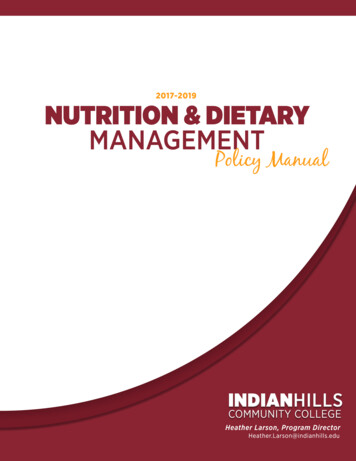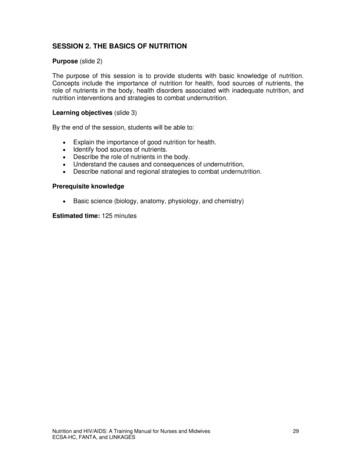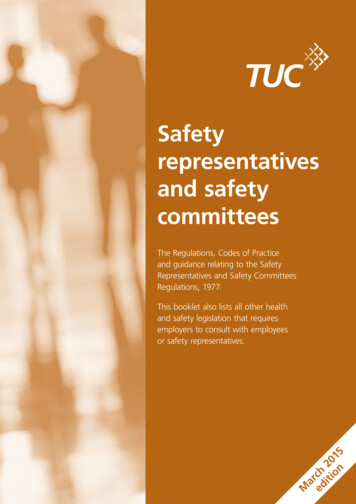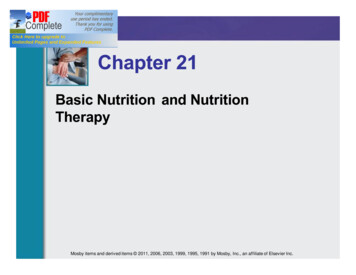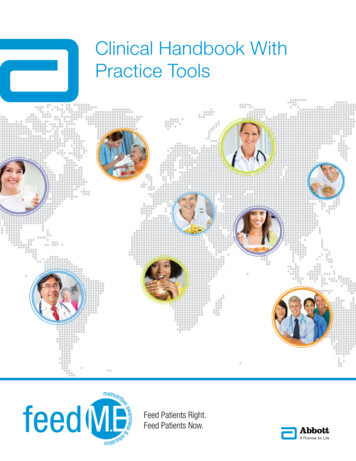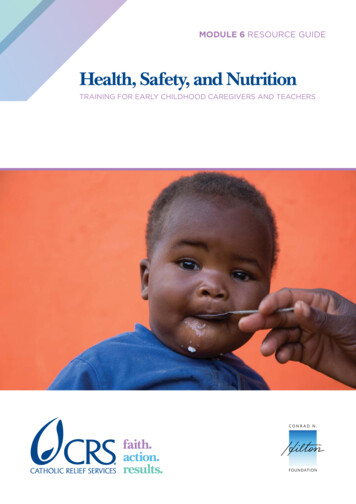
Transcription
MODULE 6 RESOURCE GUIDEHealth, Safety, and NutritionTRAINING FOR EARLY CHILDHOOD CAREGIVERS AND TEACHERS
MODULE 6 RESOURCE GUIDEHealth, Safety, and NutritionTRAINING FOR EARLY CHILDHOOD CAREGIVERS AND TEACHERSHEALTH, SAFETY, AND NUTRITIONi
This guide is part of a series of manuals that focuses on six topics in EarlyChildhood Development (ECD): different programming approaches, basic concepts,assessments, early childhood environments, children with special needs and childprotection, and the health, safety and nutrition of young children. The series wasprepared within a three-year CRS-led project called “Strengthening the Capacity ofWomen Religious in Early Childhood Development,” or “SCORE ECD.” Fundedby the Conrad N. Hilton Foundation, the project helps Catholic sisters in Kenya,Malawi, and Zambia in their work with children aged 0-5 years and their families.The project is being implemented from January 2014 to December 2016.CRS referred to a wide range of documents in preparing this curriculum. Please see “Reference Documents”section in Module 1 facilitator or resource guide for the full list.Written by Selamawit Tadesse, in cooperation with CRS SCORE ECD team.Edited by David SnyderCover photo: Pilarini James, 8 months, is fed by his mother in Chinganga Village near Zomba, Malawi. Hismother participates in a CRS project funded by the Hilton Foundation that trains new and expectant mothersin nutrition and hygiene. Sara A. Fajardo/CRSCopyright 2016 Catholic Relief ServicesAny reproduction, translation, derivation, distribution or other use of this work is prohibited without theexpress permission of Catholic Relief Services (“CRS”). Please obtain permission from pqpublications@crs.org or write to:Catholic Relief Services228 West Lexington StreetBaltimore, MD 21201-3443 USAiiMODULE 6 RESOURCE GUIDE
Table of ContentsRESOURCE GUIDE 6: HEALTH, SAFETY, AND NUTRITION OF YOUNG CHILDREN . 1Purpose.1SESSION 1: HEALTH AND SAFETY OF YOUNG CHILDREN.3Learning objectives.3Health and safety of young children.3Germs and their effect on health.4Keeping children safe .7Childhood illnesses: Integrated Management of Childhood Illnesses (IMCI)and ideas for working with caregivers .10Ideas for working with parents and family caregivers. 13SESSION 2: GROWTH AND NUTRITION OF YOUNG CHILDREN.17Learning objectives. 17Caring for the child’s healthy growth and development: WHO-UNICEFtraining manual. 17REFERENCES.19HEALTH, SAFETY, AND NUTRITIONiii
RESOURCE GUIDE 6: HEALTH, SAFETY, AND NUTRITIONResource Guide 6 is one of six ECD Resource Guides from the CRS SCORE ECD curriculum.The six series are:1.Approaches to Early Childhood Programs2.Introduction to Early Childhood Development3.Assessing Young Children’s Development4.Quality Early Childhood Environments for Young Children5.Children with Special Needs and Child Protection6.Health, Safety, and NutritionSAMPLE REVIEW“We have been helped in this training to know how to care for the health and safetyof children. Sisters will be taking appropriate precautions in treating injuries, sickness,and giving good nutrition to children, counseling parents on the importance ofexclusive breastfeeding, and preparing nutritional food using what they grow in theirbackyards.” (Reviewer: Master Trainer, SCORE ECD project, Zambia, August, 2015)“The curriculum was helpful because I have learned more about nutrition and howto give good food to children according to their different developmental stage.”(Reviewer: Master Trainer, SCORE ECD project, Zambia, August, 2015)“Sisters were empowered to make use of what we have in the environment and becreative to help families and children keep their health in good condition; we createda tippy-tap to provide families with clean running water for handwashing; we learnedhow to practically monitor growth of children using graphs; we learned how tocounsel mothers in breastfeeding and preparing locally grown nutritious food forchildren of different ages.” (Reviewer: Master Trainer, SCORE ECD project, Zambia,August, 2015)ivMODULE 6 RESOURCE GUIDE
Resource Guide 6:Health, Safety, and Nutritionof Young ChildrenPURPOSEThe purpose of this guide is to increase the participants’ understanding of childhoodillnesses and injuries, their influence on children’s development, and what caregiverscan do to prevent and/or treat illnesses and injuries in children. The participantsare also expected to learn about nutrition and its importance in Early ChildhoodDevelopment (ECD) and what caregivers can do to promote good nutrition for youngchildren, including children living with HIV. This guide is divided into two sessions:1.Session one describes the importance of sanitation, safety, and prevention ofchildhood illnesses for young children. Topics include universal precautions,personal hygiene; food safety; safe drinking water; preventing injuries; andintervention with Integrated Management of Childhood Illnesses (IMCI) with a focuson children living with HIV.2. Session two describes the importance of nutrition for young children’sdevelopment and nutrition strategies by age for optimum health and developmentof all children. Topics include responsive feeding and care practices for youngchildren, supporting families to improve infant and young child feeding practices,growth monitoring, and reinforcing healthy eating habits in young children.HEALTH, SAFETY, AND NUTRITION1
Session 1: Health and Safety ofYoung Children1LEARNING OBJECTIVES1By the end of this session, the participants will be able to: Describe the effects of germs on health. Identify ways to prevent germs from spreading among children and adults. Define “Universal Precautions” and the need to use universal precautions all the timewhen dealing with blood and bodily fluids. Put measures in place to prevent accidents in and around the home and school. Respond quickly and appropriately to accidents. Describe common childhood illnesses and the danger signs of childhood illnessesthat require urgent medical attention. Identify steps that are helpful to prevent or treat childhood illnesses.HEALTH AND SAFETY OF YOUNG CHILDRENImportant: This session needs to be conducted by or with the assistance of alocal health and nutrition professional. Also, have the national or district healthand safety protocol guidelines on hand for reference throughout the session.1This session is adopted from CRS, Lesotho (2012), Ngoana Eo Ke Oa Mang? Parent and family caregiver manual.HEALTH, SAFETY, AND NUTRITION3
GERMS AND THEIR EFFECT ON HEALTHChildren can get sick through germs. Germs are very small living things that makepeople sick if they get inside their bodies. They are spread in many ways. For example: Through the air when we sneeze Though contact with human feces or urine By touching something that has germs on it Through contact with blood and their body fluidsSanitation or cleanliness is the best way to stop germs from spreading, so practice itin the home and the community at all times.ELEMENTS OF SANITATION AND SAFETYUNIVERSAL PRECAUTIONSWe cannot tell by looking if someone is infected with HIV. This means we need totreat all blood (and body fluids containing blood) as if it is infected with HIV. Teach children not to touch other people’s blood and body fluids. A child who is hurt and bleeding needs immediate attention. Use latex/rubber gloves or plastic bags to protect your hands when dealing withcuts, bleeding or opens sores, and when cleaning up blood spills. Keep the child in one place until you have controlled the bleeding. Wash hands immediately after any contact with blood. Cover grazes, cuts, and open sores with a clean piece of cloth or bandage. Place bloody clothes or paper in double plastic bags before you put them in therubbish bin. Wash the blood stained area with a disinfectant solution. Soak any mops or cleaningcloths in the disinfectant solution and let them dry in the sun.BODY AND HAND WASHING AND ITS IMPORTANCE Appropriate hand washing can minimize germs on the hands thatcome from contact with bodily fluids and contaminated surfaces,or touching dead animals. Body/hand washing breaks the chain of infection transmission andreduces the spread of infection from one person to another. All caregivers and staff who provide care for children and adultsmust practice effective body/hand washing. Children and adults also need to be instructed in proper techniquesand situations for body/hand washing. Washing with soap and water kills many germs and allows them tobe removedby rinsing.4MODULE 6 RESOURCE GUIDEDO NOT USECOMMON TOWELSBECAUSE THEYSPREAD INFECTION.
FACILITIES AND MATERIALS REQUIRED FOR BODY/HAND WASHING Access to clean water is essential. Running water is best. As many homes do not have running water, it is best to pour a small amount of waterfrom either a bucket with a tap, which can be turned on and off, or a bucket andpitcher to pour water for rinsing. Facilities for drying hands: Disposable towels or reusable single use towels or rollertowels, which are regularly washed, should be available. If there is no clean dry towel,it is best to air-dry hands.TIPPY-TAPThe tippy-tap is a simple device that allows people to wash their hands with verylittle water. It also allows the user to rub his/her hands together while water runs overthem. It is made of materials that are available at no cost in most places and can beput wherever people need to wash their hands, for example, near the cooking stove,at the toilet, or in rural food stores.HOW TO MAKE A PLASTIC TIPPY-TAPTo make this tippy-tap you need: 1) a plastic bottle with ascrew-on cap of the sort that cool drinks come in, and 2) theinside tube from a ball-point pen, or some other small, stiff,hollow tube.CLEAN THE TUBE Using a heated piece of wire, make a small hole in the lowerpart of the bottle. Remove and clean the inside tube from a ball-point pen. Cut itoff at an angle, and push it through the hole in the bottle. Thetube should fit tightly. Fill the bottle with water and replace the cap. When the cap istight, no water should flow through the tube. When the cap isloose, water should flow out in a steady stream. When you aresure that it works, hang it or place it on a shelf where peoplecan use it for hand-washing. Keep soap nearby, or thread abar of soap with string and tie it to the bottle. To use the tippy-tap, loosen the cap just enough to let thewater flow; wet your hands, apply soap, and rub your handstogether under the water until they are clean.Tippy-taps can also be made with different designs and fromdifferent materials. Another that is common is made from adried calabash gourd.BRUSHING TEETHChildren need to learn to care for their teeth and gums to keep them healthy. Never put a baby down to sleep with a bottle filled with formula, milk, juice, orsweetened drinks. The sugar in these liquids can cause tooth decay. If the baby needshis/her bottle, fill it with water. Do not give children too many sweets, cakes, or bubbly cold drinks because it rotstheir teeth. Teach children to brush their teeth every day with a toothbrush and with salt andHEALTH, SAFETY, AND NUTRITION5
bicarbonate of soda. If there is no toothbrush or toothpaste, they can rub their teethwith salt and bicarbonate of soda.TOILETS AND LATRINES Teach children to use the latrine or toilet and to wash their hands with soapproperly afterwards. If there is no latrine or pit, children should go far from the house, and then cover itwith sand. An adult must always inspect the child when he/she comes from toileting to ensurethey have not messed themselves and have cleaned themselves properly and washedtheir hands. Keep toilets and latrines clean with disinfectant mixed with water to stop germsfrom spreading.KEEPING FOOD SAFEGerms can spread when we do not wash our hands properly, and they can also bepassed on by eating food that is not clean or is old. When food is not prepared,cooked, or stored properly, germs grow in the food and it goes bad.PREPARING FOOD Wash hands thoroughly with soap and water before preparing and serving food. If you have to change the baby’s diaper while working with food make sure you washyour hands thoroughly with soap when you are through. Cover the food as it is prepared to keep the flies away. Wash or peel all fruit and vegetables that are eaten raw. Do not cough or sneeze near food or into your bra, especially if you arebreastfeeding. Throw food out when it has a bad smell or taste, changes color, or has bubbles orslime on the top. It is better to let dishes air dry or dry in the sun than to dry them with a dishcloth. Keep the cooking area clean. Cover bins to keep out the flies and cockroaches, and bury or burn the rubbish. Makesure the rubbish is buried deep enough to keep animals and rodents away.CUP FEEDINGIt is not always possible to properly clean and sterilize baby bottles. When thisis the case, cup feeding is recommended as a safe alternative to bottle feeding.Cups can be easily washed with soap and water and babies are less likely tocarry them around and get them dirty.6MODULE 6 RESOURCE GUIDE
COOKING FOOD Cook meat and fish well to kill germs. Do not reheat food more than once. Do not give babies or young children leftover food.STORING FOOD Keep food covered to protect it from cockroaches, flies, and other insects. Keep food in a cool, dry place in sealed containers. Store the food containers on a shelf above the floor. Make sure meat juices do not leak onto other food. Throw away rusted, dented, or bulging tinned stuff. Cook only the food the child is going to eat each day.CLEAN WATERWater that does not appear to be dirty may still contain germs or chemicals thatcan make people very sick. Water that comes from taps has usually been cleanedwith chorine. We need to make sure that water that comes from other places such assprings or wells or community taps is safe for drinking, even if it looks clean.To purify water, first clean the containers well with soap and water and then use oneof the following methods: Pour water into clean glass or plastic containers and leave them in bright sunlightfrom morning until evening, for at least eight hours. This will kill most of the germs. Boil water for ten minutes to ensure the water is clean to drink. Start counting the tenminutes once the water starts boiling. Only do this if there is no other way to purifywater because it uses a lot of fuel.KEEPING CHILDREN SAFEYoung children should be protected from possible hazards such as burns, choking,falls or injuries, drowning, poisons, and childhood illnesses.SAFETY PRECAUTIONS Always check the temperature of water before bathing an infant. Do not bring hot beverages or appliances near the infant; protect the child fromtouching hot objects; check the temperature of bottles before offering them to an infant. Always hold the infant in an upright position while feeding; do not prop bottles. Always check for the infant becoming squeezed in open cracks; do not over-dressthe baby for sleep, and place the baby in the crib on his/her back. These canprevent suffocation. Always put infants to sleep on their backs to avoid suffocation and remove all softand small items from baby cribs. Do not let young children play with or put small things in their mouths that they canswallow and choke on; keep pins, buttons, small beads, nuts, seeds, coins, wholegrapes and other sharp objects out of the child’s reach. Attend to an infant at all times because the baby may turn or roll over unexpectedly. Never leave a young child alone near water sources; they can drown in very shallowwater in a matter of minutes. Make sure children do not play near springs or waterwells. Cover buckets of water with lids. Cut food into small pieces and insist that the child sit down to eat.HEALTH, SAFETY, AND NUTRITION7
Regularly check indoor and outdoor environments and remove dangerous thingsthat can hurt children, e.g., pieces of glass, tins, plastic bags, poisonous plants, rottenfoods, or any other harmful things. Keep children away from rubbish dumps. They can get ill from breathing in poisonedair from dangerous waste products or from diseases carried by flies, rats, and mice. Teach children about safety, particularly safety in the road, safety around fire, safetyaround water-filled dams and rivers, and safety around deep pits and hanging cliffs.STRANGER DANGER!It is important for young children to feel safe and secure in their world among people that they cantrust. Sadly it is a fact that children of all ages are at risk of being taken away, raped, or killed.Children should not be allowed to wander off alone. Parents and family caregivers need to watch theiryoung children and know where they are at all times. It is important to teach children the rules that: They are not allowed to play where adults cannot see them. They should never go off with anyone without a parent or caregiver knowing where they are or whothey are with.GOOD TOUCHES AND BAD TOUCHES!Parents and family caregivers should explain the difference between good touches and bad touchesand encourage their children to refuse boldly when they do not want to be touched, particularly beingtouched on their private parts by other people.Parents and family caregivers can work together to make sure their children are safe. If one parentneeds to go to the shop she can ask her neighbor to care of the child. In exchange she will do theshopping for her neighbor.HELPING YOUNG CHILDREN WHO ARE HURTWhen a child is hurt, seek emergency professional help from the local health or socialservices in the community. You can help the child with some first aid measures whilewaiting for professional help.Always make sure you have local emergency contact information. It is helpful to writethe details. For example: Police emergency Local health clinic Hospital Child protection service in the locality Others as relevant8MODULE 6 RESOURCE GUIDE
SERIOUS FALL OR INJURYIf the child is bleeding, place a clean cloth and make pressure until the bleeding stops.Remember to use universal precautions (protect your hands from contact with blood).If the child is not breathing, first put the child on a hard surface and then carry out thefollowing steps:1.Lift her jaw, tilt her head back and hold her nostrils closed.2. Breathe into the child’s mouth hard enough to make her chest rise.3. Count to three and repeat the action.4. Do this until the child starts to breathe.BURNS Immediately apply cold water to the burn for about ten minutes. If it is a large burnput the child in a bath or container of cold water for 20 minutes or longer. Then, getthe child to a clinic or health center. If the child catches alight, wrap him in a blanket or roll him on the ground to put outthe fire. Do not try to remove the clothing or anything else sticking to the skin or breakthe blisters. Do not put anything on the burn except water!CHOKINGIF IT IS A BABYIF IT IS A CHILD OLDER THAN ONEYEAR Carefully turn him so that his head is lowerthan his feet. First try to remove the object withyour finger. Hit him five times on the back betweenthe shoulder blades. Hit the child five times on the backbetween the shoulder blades. Turn him face up and place two fingertipsin the center of the breastbone just belowthe nipple line. If this doesn’t work, stand behind the childand wrap your arms around his waist. Putyour fist against his belly above the naveland below the ribs. Push inwards and upwards towards thehead to try to dislodge the object. Give quick sharp upward thrusts intothe child’s abdomen until the object isremoved. Check the baby’s mouth after each thrust If this doesn’t work after several attempts,get emergency help immediately. Keepgiving thrusts until help arrives. If this doesn’t work after several attempts,get emergency help immediately. Keepgiving thrusts until help arrives.POISONING Do not give the child anything to eat or drink or try to make her vomit. If there is poison on the child’s skin or clothing remove all contaminated clothing andrinse the skin with water for at least ten minutes. If there is poison in the child’s eyes, splash water in the eyes for at least ten minutes. Get the child to the clinic or health center as soon as possible.HEALTH, SAFETY, AND NUTRITION9
CHILDHOOD ILLNESSES: INTEGRATED MANAGEMENT OFCHILDHOOD ILLNESSES (IMCI) AND IDEAS FOR WORKINGWITH CAREGIVERSThe World Health Organization (WHO) and UNICEF have developed a way to improvechild health and ensure that young children do not die from preventable illnesses suchas pneumonia, diarrhea, malaria, measles, and malnutrition.Because many children often suffer from concurrent illnesses, the focus is on the childas a whole rather than on one particular illness.Many child deaths could have been prevented but parents and family caregivers andother caregivers often do not know that their child is seriously ill and do not take him/her to get treatment before it is too late.WHO has identified a number of danger signs that parents and family caregivers need tolearn so they will know when a child needs to receive immediate and urgent medical help.URGENT WARNING SIGNS The child is unable to drink or breastfeed. The child vomits everything. The child has had convulsions with his/her illness. The child is lethargic. The child’s chest is indrawn. The child is convulsing now.OTHER SIGNS THAT A CHILD IS VERY ILL ARE: Rapid breathing, diarrhea, or vomiting Fever Ear problemsCHILDREN AT HIGH RISK OF HIV INFECTIONIMCI also provides guidelines for identifying children at high risk of HIV infection and/or tuberculosis (Pediatric TB): The child has pneumonia. The child has had an ear discharge. The child is underweight for his/her age. The child is failing to gain weight or has lost weight. The child has had diarrhea lasting for 24 days or more (now or in the past three months). The child has enlarged lymph glands in two different places (neck, armpit, or groin). The child has thrush in his/her mouth. The child has an enlarged parotid gland.Note: When a child has three of the above conditions the health worker willrecommend to the mother that the child be tested for HIV infection and tuberculosis.10MODULE 6 RESOURCE GUIDE
TREATING DIARRHEADiarrhea is a common problem for young children when safe hygienic measures arenot taken. Babies and young children lose fluids from their bodies (dehydrate) veryquickly. This is very dangerous because a child can die if he/she loses too much water.To make sure children with diarrhea do not dehydrate, give them plenty of liquids todrink, e.g., water, breast milk, thin soups.ORAL REHYDRATION SOLUTIONThere is a special drink that caregivers can give to the child when he/she has diarrhea.It is made of sugar, water, and salt:WHO and IMCI recommend mixing a package of Oral Rehydration Salts (ORS) in oneliter of boiled water. Wash your hands with soap and water before preparing the solution. Mix until the sugar and salt are dissolved. Give the ORS with a spoon to the child until he/she is rehydrated (e.g., is able tourinate or cries with tears). Once hydrated, give ORS after each defecation until the diarrhea stops. Give more food and breastfeeding to the child. Seek care at the nearest point of care.Note: Encourage the child to keep eating. If the mother is breastfeeding she shouldcontinue to do so.TREATING A FEVERWhen a child is sick his/her body temperature can rise above or below normal. Afever is a rise in body temperature and high fever can be especially dangerous in ayoung child. He/she may look flushed, be sweaty, or feel hot.Treat a fever by: Give Paracetamol for high fever ( 38.5 C). For children between two months and upto three years, give one tablet of 100 mg. Dressing the child in cooler clothing (warm clothing can cause the fever to go higher) Giving cool clean water or other fluids to drink Putting the child where there is fresh air in a cool place Wiping or sponging him/her with a cool, damp cloth Making sure the child passes urine regularlyTRADITIONAL MEDICINESSometimes traditional ways of treating sicknesses work well. For example, herbsand herbal remedies are used to prevent and treat colds, headaches, sleepproblems, burns, toothaches, stomachache, and many more.Some serious diseases are treated better with modern medicines. It isimportant for health workers and educators to respect family tradition, butat the same time know when such treatments could do more harm than goodand even put a child’s life at risk.HEALTH, SAFETY, AND NUTRITION11
IMMUNIZATIONSFrom birth, it is important to protect children against dangerous childhood illnessesthat can cause death. Immunizations fight off diseases such as the ones shown in thetable and bullet points below:Adapted from UNICEF Zambia: Integrated Management of Childhood Illness Caring for theChild’s Healthy Growth and Development. Whooping cough Tetanus Diphtheria Hib infection, which causes meningitis Hepatitis B, which causes liver damage Measles Tuberculosis Polio Pneumococo, which causes pneumonia Rota virus, which causes diarrheaIt is important that every child is immunized and completes the full immunizationschedule according to each country policy or the vaccines may not work. Theschedule for immunization is as follows: At birth:BCG and polio 6 weeks:DPT, polio, Hib, and Hepatitis B (these schemes vary by country) 10 weeks:DPT, polio, Hib, and Hepatitis B 14 weeks:DPT, polio, Hib, and Hepatitis B 9 months:Measles 18 months:DPT, polio, and measles12MODULE 6 RESOURCE GUIDE
IDEAS FOR WORKING WITH PARENTS AND FAMILYCAREGIVERSHOME VISITS During many of the home visits related to this chapter you will want to speak directlyto the parent. Collect a few playthings for the child beforehand or at the home whereyou are visiting. Use the following flip book message for discussion or make one yourself based onthe information in this chapter.PREVENTING THE SPREAD OF DISEASESTask: Include the father, mother, and other members of the family in your home visitsession with them. Discuss the picture above and ask the parents or caregivers when they thinks it’simportant to wash hands. Ask what types of water and washing facilities the families are using. Talk about how important it is to use running water when washing hands and discusshow family members can do this when they do not have taps. Also explain thatwashing the body is part of personal hygiene. You can bring a tippy-tap along and demonstrate how it can be used or ask thecaregivers if they have similar ones. If they don’t have one and there is a suitablebottle or container and tube available, show the caregievrs how to make a tippy-tap. If this is not possible, demonstrate how the child can wash hands using running waterby pouring a small amount of water into the container, washing hands, and thenpouring some water over the hands to rinse.HEALTH, SAFETY, AND NUTRITION13
A SICK CHILDTask: Discuss how the parent knows when his/her child is sick and what steps are taken. Find out whether the parent knows when their child is dangerously sick and needs toget medical help. Explain that there are signs that the child needs urgent attention. At this time youshould explain the danger signs. Demonstrate how to make ORS to stop dehydration when a child has diarrhea. Talkabout how important it is to make sure the child does not dehydrate, as he/she candie in as little as six hours from loss of water and salts.14MODULE 6 RESOURCE GUIDE
IMMUNIZATIONSTask: Ask to see the child’s immunization card and check that the immunizations are upto date. If they are not, explain how important these are in preventing childhoodillnesses and that if the child does not receive all the immunizations they may notwork. Praise the family if they have already followed up the child’s immunizationsas needed. Help the parents/cargivers make a plan for taking the child to the clinic.HEALTH, SAFETY, AND NUTRITION15
Session 2: Growth andNutrition of Young ChildrenLEARNING OBJECTIVES Describe the proper procedure of breastfeeding, exclusive breastfeeding, andproviding nutritious complementary foods to children. Describe ways to strengthen the caregiver-child relationship during child care activitiessuch as breastfeeding and engaging children in play, learning, and communication. Identify nutritious complementary foods for a young child by age. Describe when to introduce complementary foods to young children by age, how toprepare the food, how much and how often to offer food, and encourage children toeat them. Use a growth chart to counsel a family on the progress of child development.C
HEALTH, SAFETY, AND NUTRITION 3 Session 1: Health and Safety of Young Children 1 LEARNING OBJECTIVES1 By the end of this session, the participants will be able to: Describe the effects of germs on



